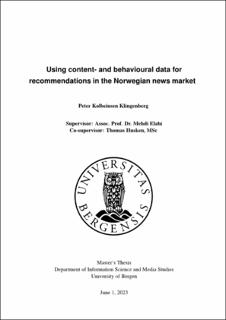| dc.description.abstract | In the news domain, the technological development has contributed to always accessible platforms with frequent publishment of articles. This leads to a vast amount of articles, in addition to a multitude of choices. Interactions executed by users (clicks, views or ratings) and content of articles (text, section, etc.) on such platforms can be utilized to create personalised recommendations. However, there can arise a situation where there is a lack of data, i.e., when a new article is published or there is a new user, known as the cold start problem. In addition, personalised recommendations in the news industry, where user behaviour are the basis of recommendations, are more complex in comparison with, for example, the movie domain due to the timeliness with short duration and relevance of articles. Recommendations provided by content data may mitigate this issue. This thesis investigates the viability of using both content- and user-behavioural data to generate recommendations in the Norwegian media market in collaboration with one of Norway’s largest newspapers, i.e., Bergens Tidende (BT). The first technique investigated is collaborative-based filtering, built on the recommender models Alternating Least Squares, Bayesian Personalized Ranking and Logistic Matrix Factorization, which is specially tailored to use user behavioural data as input. The second technique investigated is content-based filtering, built on a state-of-the-art architecture named BERT, specially trained to draw the semantic content of sentences in the Norwegian language. A comprehensive offline evaluation of both techniques is executed using dimension reduction and a diverse selection of accuracy metrics. In addition, an online evaluation of a large-scale A/B test of the content-based filtering technique against a former recommendation technique in BT is performed. The evaluation methods used in the online experiment are descriptive data- and Bayesian analysis. The results of the collaborative filtering technique have shown increased performance in different stages of filtering, in addition to the importance of hyperparameter tuning. The results have shown promising performance based on the content-based filtering technique, indicating that this attracts users' interest at a greater scale, even the groups that usually show less interaction. | |
